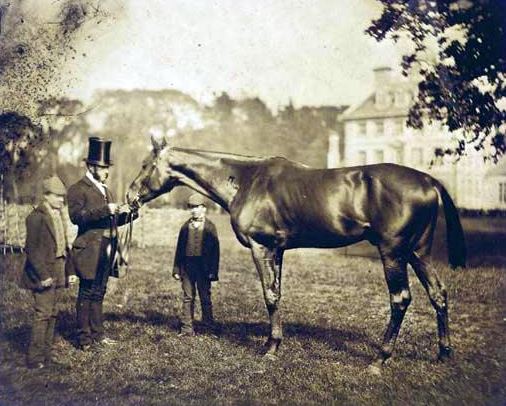
The First Racehorse Meetings in Lambourn
William Craven the 3rd Baron 1700-1739
His main seat was Coombe Abbey but used his seats at Ashdown and Benham.
Ashdown Uffington estates were previously purchased by William Craven the 1st Baron and 1st Earl of Craven (1608-1697) in 1625 which included Ashdown Park and five years later he purchased Benham Park House. In 1662 he started to build Ashdown House which is said to be consecrated to the Queen of Bohemia.
William Craven the 3rd was a Racehorse owner and breeder. In 1727 he started the Wantage Racehorse Meetings on his property on Letcombe Downlands; one more meeting was held in 1728. In 1731 he started the Lambourn Racehorse meetings on his property near Ashdown House on Bailey Hill Downlands. He was succeeded by his brother, Fulwar Craven the 4th Baron 1702-1764
Fulwar Craven owned 70,000 acres spread over various counties of which about a third was in Berkshire. He founded the Craven Hunt which was one of the earliest in 1740 and in the same year founded Ashdown Hare Coursing meetings. Fulwar was Master of the Craven Hounds, a founder member of The Jockey Club, Racehorse owner and breeder. In 1740 he held the Lambourn Racehorse meeting on Bailey Hill Downlands. The Race Meetings were discontinued for the next eight years, probably due to the 1740 Parliament Act which was aimed to reduce the small Racehorse Meetings by making each race worth £50. The Lambourn Racehorse Meetings then took place at Bailey Hill Downlands for another fifty four years. Fulwar died unmarried and was buried at the St Mary’s Churchyard Hamstead Marshall. He was succeeded by his cousin, William Craven 5th Baron 1705-1769. He had been an MP for Warwickshire but when he became Baron he lived in his various seats. He was Master of the Craven Hunt, a member of The Jockey Club, Racehorse owner and a Steward at Racehorse Meetings and was a keen supporter of the Lambourn Racehorse Meetings. He was succeeded by his Nephew, William Craven 6th Barron 1738-1791. He married 16yr old Lady Elizabeth Berkeley in 1767 and had 7 children, their first home was at Ashdown House for two years. Again, he was Master of the Craven Hunt, Member of the Jockey Club, Racehorse owner with a Stud and Benham Park and a Steward at Racehorse Meetings.
His support for the Newmarket meetings led to the introduction of the two day Craven Meeting at Newmarket which was started in 1771. The Craven Stakes was first run in 1878. In 1791 he died while on holiday in Switzerland. He was succeeded by his eldest son William Craven 7th Baron and recreated 1st Earl of Craven 1770- 1825. He revived the Wantage Racehorse Meetings in 1793 on his property on the Letcombe Downlands which continued until 1796. In 1805 he started the Newbury Racehorse Meetings on his land at Enborne which is just outside Newbury. The meetings continued to be held there until 1811.
After his death he was succeeded by his eldest son William Craven 2nd Earl 1809-1866 He married Emily Mary Grimston and Ashdown House became their main home. He had a very fine State Coach built by Hooper & Company London around 1851. In 1840 he had a Golf Course made a Cricket Square laid and started the Craven Cricket Club later known as the Ashdown Cricket Club. He became President of the Marylebone Cricket Club at Lords in 1841. He won the 1841 Grand National with his horse ‘Charity’ and was co-owner of the 1855 Derby winner ‘ Wild Dayrell ‘ ridden by J.Rickaby, which was trained at Ashdown. In 1865 he revived the Lambourn Racehorse Meeting at Weathercock Hill Gallops near Ashdown. After an illness in 1866 he died owning fifty five thousand acres. He was succeeded by his second son George Grimston. His eldest son, William Viscount Uffington, who was a Captain in the Grenadier Guards, died aged twenty-six.
George Grimston 3rd Earl of Craven 1841-1883 married the Hon Evelyn Barrington in 1887 and they made Ashdown House their main home. The main stable block with the clock tower and caged boxes were built. There was a large staff working in Ashdown House and about six gardeners. The Earl was a Steward at Racehorse Meetings and held the Lambourn Racehorse Meetings on his property at Weathercock Hill Gallops from 1876-1878.

Sadly, nothing other than the ruins of the Rubbing House remains of the racecourse at Weathercock Hill and the only reminder of its association with Racing is the Racing Stable named Weathercock House which is where Warren Greatrex now trains.
Ashdown House passed on to William George Robert Craven 4th Earl of Craven 1868-1921 and after his death the Countess of Craven was left in sole control of the Estates. In 1921 she moved into Hamstead Lodge and in 1956 the Dowager Countess of Craven gave Ashdown House, with forty acres, with a covenant over a further 248 acres and an endowment to The National Trust. From 1956-1960 the Uffington – Ashbury Estates of about 6,000 acres were sold ending the Craven Family connections with the location.
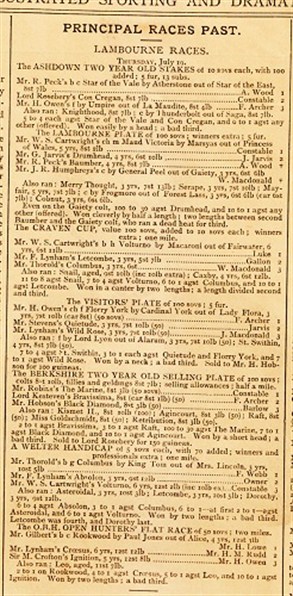
The above is taken from ‘The Illustrated Sporting and Dramatic’ dated July 28th 1877. This was a high-class Weekly Journal, published by George Maddick, Junr, at the Office, 148, Strand. London and shows the Lambourn Racing Results for July 19th 1877.
Lambourn Racehorse meetings on Bailey Hill Downlands were held from 1731-1803.
The map of Berkshire 1761 by John Rocque shows the Lambourn Racehorse Course. By comparing the map of 1761 and the Ordnance Survey map and taking a line from the Warren and Fognam Farm it shows that the Lambourn Racehorse Course is on the edge of Bailey Hill Downlands.
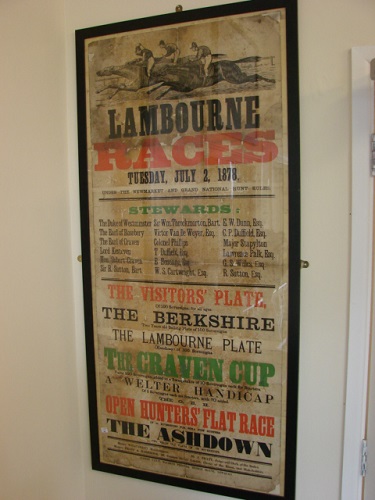
The London Evening post 1779 states that races start from the post on Bailey Hill. The Bailey Hill and adjacent Downlands would have been ideal for the early race meetings four miles races.
In 1878 the Racing Calendar stated “The course is in a shape of a figure of nine, the straight side of which is rather over a mile with a slight rise and fall throughout” There was a twenty foot wooden tower stand which the Stewards would have used for the Race Meetings next to a Rubbing House for the horses until the 1950’s
In 1877 the Champion Jockey F.Archer rode a winner at the Race Meeting.
Since 1967 the gallops which were one hundred and twenty seven acres were ploughed up and have since been cultivated farmland.
Lambourn Racehorse Meetings :
- 1731-1740
- 1865
- 1876-1878
Other meetings also held on Craven Estates Property were also held at Wantage, Reading, Ilsley, Abingdon, Marlborough, Newbury, Faringdon, Burderop, Highworth, Hungerford and Swindon from 1727-1874

Wild Dayrell was very backward and immature in the early part of his two-year-old season, and showed very little ability in his training gallops at Goodwood. The colt was therefore put up for sale again and was bought back by Popham for 250 guineas and returned to Littlecote, where Rickaby took over his training. Popham then sold a share in Wild Dayrell to Lord Craven and the colt’s training base was moved to Craven’s estate at Ashdown Park As his owners had no other racehorses, Rickaby trained Wild Dayrell at Ashdown by galloping him against various hacks and hunters
Liz Beard
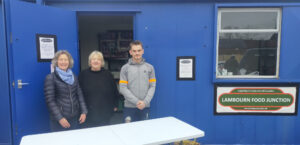


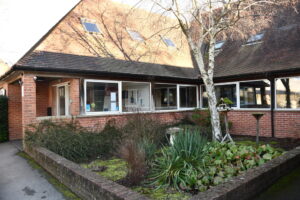
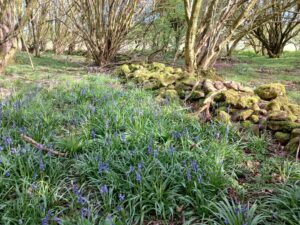
I do not wish to contradict your history of the Craven family but Ashdown House was bought in the 1950’s by John Goulandris. He restored the house and grounds. He also modernised the bedrooms and put up some of his artworks. We stayed there often. He then gave the house to the National Trust.
Hello Mariella
Thank you for contacting the website. This was very interesting to read and therefore I needed to discover more! Yes, John Goulandris did lease Ashdown House.
The information on the website is from the Ashdown House history but further information does state that, ‘Ashdown House has been owned since 1956 by the National Trust — having been donated by Cornelia, widow of the fourth Earl of Craven (second creation) after the house was more or less wrecked by the army during their sojourn there in the Second World War — and following a phase in which it was leased by shipping tycoon John Goulandris, and from 1984-2010 the tenants there have been Max Ulfane, businessman and philanthropist, and his wife Joy’ Both families have been involved in restoring this beautiful house and may future tenants continue to do so. How fortunate that you were able to stay there.